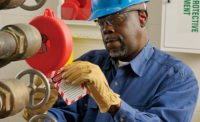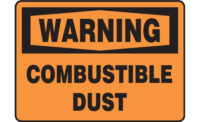The National Fire Protection Association (NFPA) began addressing combustible dust with industry-specific standards dating as far back as 1920. NFPA® 652, Standard on the Fundamentals of Combustible Dust, is the first comprehensive standard to provide general requirements for the management of combustible dust fire and explosion hazards. It became effective on September 7, 2015.
What makes combustible dust dangerous?
In its Combustible Dust National Emphasis Program (NEP), OSHA defines combustible dust as a “solid combustible material composed of distinct pieces or particles, that presents a fire or deflagration hazard when suspended in air or some other oxidizing medium over a range of concentrations, regardless of particle size or shape.” Deflagration is the chemical process where a substance rapidly and intensely burns.
NFPA® 652 defines combustible dust as a finely divided combustible particulate solid that presents a flash fire or explosion hazard when suspended in air or the process-specific oxidizing medium over a range of concentrations.
Types of combustible dusts include metal dust, such as aluminum and magnesium; wood dust; plastic or rubber dust; coal dust; organic dust, such as flour, sugar, paper, soap and dried blood; and dusts from certain textiles.
For combustible dust to cause a dust explosion five elements must be present. The first three are those needed for a fire – heat, fuel and oxygen. The combustible dust pentagon consists of those three, plus dispersion and confinement.
Three critical points differentiate combustible dust fires and explosions from other types of fires and explosions. First, dust particles must be dispersed in order to be ignited. Second, combustible dust fires and explosions may produce more heat and pressure then other fires. Third, the pressure and concussion caused by an initial combustible dust explosion can cause secondary explosions or fires and this chain reaction can repeat throughout an entire facility. Secondary explosions are generally more violent than the initial explosions.
Regulatory void
There isn’t a comprehensive federal standard to help employers understand how to protect their workers and facilities from combustible dust explosions. OSHA’s Combustible Dust NEP was issued in October, 2007. Following the Imperial Sugar explosion the NEP was revised (March 2008) to focus on industries with more frequent and high consequence incidents and to include more inspections. The revised NEP lists a number of combustible dust-related NFPA standards to be consulted and used as resources.
NFPA standards related directly to combustible dust hazards are:
- NFPA® 61 – Standard for the Prevention of Fires and Dust Explosions in Agriculture and Food Processing Facilities
- NFPA® 484 – Standard for Combustible Metals
- NFPA® 654 – Standard for the Prevention of Fires and Dust Explosions from the Manufacturing, Processing, and Handling of Combustible Particulate Solids
- NFPA® 665 – Standard for the Prevention of Sulfur Fires and Explosions
- NFPA® 664 – Standard for the Prevention of Fires and Explosions in Wood Processing and Woodworking Facilities
With the exception of NFPA® 654, all standards are industry specific. NFPA® 654 is viewed as filling the “everything else” gap, but it does focus broadly on the chemical processing industry.
Users have noted conflicting information in these standards, which led to the development of NFPA® 652.
Impact of NFPA® 652
NFPA® 652 establishes the relationship and hierarchy between it and the industry-specific standards. Its purpose is to provide minimum general requirements for managing combustible dust hazards and direct users to the appropriate NFPA standards for a specific industry or commodity.
NFPA® 652 directs employers to first identify combustible/explosive dust hazards and then implement needed protective measures and safeguards by September 2018. If a dust is identified as combustible or explosive, a dust hazard analysis (DHA) must be conducted to determine if existing workplace conditions could cause the dust to ignite and combust/explode. NFPA® 652 has three fundamental principles - contain the fuel, control the ignition sources, and limit the spread of any event. All are addressed by conducting a DHA. Needed protective measures and safeguards are identified by performing hazard risk assessments as described in NFPA® 2113 – Standard on Selection, Care, Use, and Maintenance of Flame-Resistant Garments for Protection of Industrial Personnel against Short-Duration Thermal Exposures from Fire. A summary of the action items for facilities with potentially combustible and/or explosive dusts is outlined below.
NFPA® 652 specifically addresses PPE and flame-resistant (FR) clothing in Section 8.6. It requires employers to conduct a hazard assessment, and if FR garments are needed, employers must provide them. The standard specifically requires dust inspection of the garments and mandates that a policy addressing care, cleaning and maintenance of the garments be implemented.
The other significant change that NFPA® 652 speaks to is the emphasis on training and awareness. Workers (temporary, contractors, and visitors – not just employees) must undergo general awareness and job-specific training on hazard awareness, safe work practices, and the inspection, testing and maintenance of equipment.
The NFPA’s standards are the backbone of OSHA’s combustible dust enforcement tools. Since issuing the NEP directive, OSHA hasn’t made any significant progress in developing its own combustible dust standard; the NFPA standards are still the basis for managing combustible dust hazards. NFPA® 652 is the newest NFPA combustible dust standard and the starting point for defining a combustible dust and its hazards.



